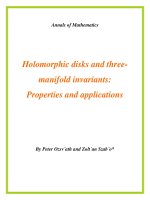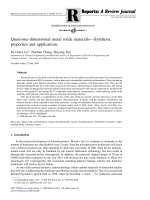hyperbranched polymers synthesis, properties, and applications
Bạn đang xem bản rút gọn của tài liệu. Xem và tải ngay bản đầy đủ của tài liệu tại đây (21.35 MB, 481 trang )
Hyperbranched Polymers
Hyperbranched Polymers
Synthesis, Properties,
and Applications
Edited by
Deyue Yan, Chao Gao, and Holger Frey
A John Wiley & Sons, Inc., Publication
Copyright © 2011 by John Wiley & Sons, Inc. All rights reserved
Published by John Wiley & Sons, Inc., Hoboken, New Jersey
Published simultaneously in Canada
No part of this publication may be reproduced, stored in a retrieval system, or transmitted in any form
or by any means, electronic, mechanical, photocopying, recording, scanning, or otherwise, except as
permitted under Section 107 or 108 of the 1976 United States Copyright Act, without either the prior
written permission of the Publisher, or authorization through payment of the appropriate per-copy fee
to the Copyright Clearance Center, Inc., 222 Rosewood Drive, Danvers, MA 01923, (978) 750-8400,
fax (978) 750-4470, or on the web at www.copyright.com. Requests to the Publisher for permission
should be addressed to the Permissions Department, John Wiley & Sons, Inc., 111 River Street,
Hoboken, NJ 07030, (201) 748-6011, fax (201) 748-6008, or online at
/>Limit of Liability/Disclaimer of Warranty: While the publisher and author have used their best efforts
in preparing this book, they make no representations or warranties with respect to the accuracy or
completeness of the contents of this book and specifically disclaim any implied warranties of
merchantability or fitness for a particular purpose. No warranty may be created or extended by sales
representatives or written sales materials. The advice and strategies contained herein may not be
suitable for your situation. You should consult with a professional where appropriate. Neither the
publisher nor author shall be liable for any loss of profit or any other commercial damages, including
but not limited to special, incidental, consequential, or other damages.
For general information on our other products and services or for technical support, pleas e contact our
Customer Care Department within the United States at (800) 762-2974, outside the United States at
(317) 572-3993 or fax (317) 572-4002.
Wiley also publishes its books in a variety of electronic formats. Some content that appears in print
may not be available in electronic formats. For more information about Wiley products, visit our web
site at www.wiley.com.
Library of Congress Cataloging-in-Publication Data:
Hyperbranched polymers : synthesis, properties, and applications
/ edited by Deyue Yan, Chao Gao, Holger Frey.
p. cm.– (Wiley series on polymer engineering and
technology)
Includes index.
ISBN 978-0-471-78014-4 (cloth)
1. Dendrimers. 2. Polymers. I. Yan, Deyue. II. Gao, Chao.
III. Frey, Holger.
TP1180.D45H97 2011
668.9– dc22
2010028351
oBook ISBN: 978-0-470-92900-1
ePDF ISBN: 978-0-470-92899-8
ePub ISBN: 978-0-470-93476-0
Printed in Singapore
10987654321
Contents
Preface xiii
Contributors xv
1. Promising Dendritic Materials: An Introduction to Hyperbranched
Polymers
1
1.1 Importance of Branching 1
1.2 Polymer Architecture 1
1.3 Dendritic Polymers 3
1.4 Hyperbranched Polymers 5
1.4.1 Concept and History 5
1.4.2 Structure and Properties 8
1.4.3 Synthesis Philosophy 12
1.4.4 Applications 15
1.5 Conclusions 21
1.6 References 22
2. Polycondensation of AB
x
Monomers 27
2.1 Introduction 27
2.2 Statistical Consideration 27
2.2.1 Polymerization Behavior 27
2.2.2 Degree of Branching 29
2.3 Polymerization of AB
x
-Type Monomers 30
2.3.1 C–C Coupling Reactions 30
2.3.1.1 Metal-Catalyzed Cross Couplings 30
2.3.1.2 Diels–Alder Reactions 35
2.3.1.3 Nucleophilic Substitution by Activated Methylenes 36
2.3.1.4 Electrophilic Acylations 36
2.3.2 C–O Coupling Reactions 38
2.3.2.1 Nucleophilic Substitution Reactions by Phenoxides or
Alkoxides 38
v
vi Contents
2.3.2.2 Esterification of Carboxylic Acid Derivatives 46
2.3.2.3 Ring-Opening Reaction of Epoxides 54
2.3.3 C–N Coupling Reactions 55
2.3.3.1 Condensation of Amines and Carboxylic Acid
Derivatives 55
2.3.3.2 Nucleophilic Addition of Amines 59
2.3.3.3 Other C–N Coupling Reactions 62
2.3.4 Si–C or Si– O Coupling Reactions 62
2.3.4.1 Hydrosilylation Reactions 62
2.3.4.2 Condensation Reactions 68
2.3.4.3 Other Si-Containing Reactions 69
2.3.5 Other Coupling Reactions 70
2.3.5.1 C–O or C– N Coupling Reactions of Isocyanates 70
2.3.5.2 C–S Coupling Reactions 72
2.4 References 74
3. Synthesis of Hyperbranched Polymers via Polymerization of
Functionally Symmetric Monomer Pairs
79
3.1 Introduction 79
3.2 Theoretical Treatment of A
2
+ B
3
Polymerization 81
3.3 Polymerization of Symmetrical Monomer Pairs 84
3.3.1 Polycondensation of A
2
and B
3
Monomers 84
3.3.1.1 Polyamides 84
3.3.1.2 Polyimides 87
3.3.1.3 Polyethers 89
3.3.1.4 Polyesters 93
3.3.1.5 Polycarbonates 97
3.3.1.6 Polyurethanes 97
3.3.2 Proton-Transfer Polymerization of A
2
and B
3
Monomers 99
3.3.3 The Michael Addition Polymerization of A
2
and B
3
Monomers 100
3.4 Conclusions 104
3.5 References 105
4. Synthesis of Hyperbranched Polymers via Polymerization of
Asymmetric Monomer Pairs
107
4.1 Introduction 107
4.2 General Description of Polymerization of Asymmetric Monomer
Pairs
108
Contents vii
4.3 Hyperbranched Polymers Prepared by Polymerization of Asymmetric
Monomer Pairs
110
4.3.1 Poly(Sulfoneamine) 110
4.3.2 Poly(Ester Amine) 113
4.3.3 Poly(Amidoamine) 115
4.3.4 Multihydroxyl Hyperbranched Poly(Amine Ester)s 118
4.3.5 Poly(Ester Amide)s 120
4.3.6 Polyesters 123
4.3.7 Poly(Urea-Urethane)s 127
4.3.8 Other Polymers 129
4.3.9 Highly Branched Copolymers 131
4.4 Conclusions 133
4.5 References 136
5. Self-Condensing Vinyl Polymerization 139
5.1 Introduction 139
5.2 Self-Condensing Vinyl Polymerization 140
5.2.1 General Principles 140
5.2.2 Various Mechanisms of SCVP 144
5.2.3 Kinetics and MWD 145
5.2.4 Degree of Branching 148
5.2.5 Comparison with Experimental Data 150
5.3 Self-Condensing Vinyl Copolymerization (SCVCP) 150
5.3.1 Experimental Data 151
5.3.2 Kinetics and MWD 153
5.3.3 Degree of Branching 159
5.3.4 Comparison with Experimental Data 161
5.4 Self-Condensing Processes in Presence of Initiators 162
5.4.1 Kinetics and MWD 162
5.4.1.1 Batch Reactions 162
5.4.1.2 Semibatch Polymerization (Slow Inimer Addition)
164
5.4.2 Degree of Branching 165
5.4.2.1 Batch Polymerization 165
5.4.2.2 Semibatch Polymerization 166
5.4.3 Comparison with Experimental Data 167
5.5 SCVP of Macroinimers 167
5.6 Surface-Grafted Hyperbranched Polymers 169
5.7 References 172
6. Ring-Opening Multibranching Polymerization 175
6.1 Introduction 175
viii Contents
6.2 Classification of Ring-Opening Multibranching
Polymerizations
178
6.2.1 Cationic Ring-Opening Multibranching Polymerizations 178
6.2.2 Anionic Ring-Opening Multibranching Polymerizations 183
6.2.3 Catalytic Ring-Opening Multibranching Polymerizations 189
6.3 Core-Containing Hyperbranched Polymers By Ring-Opening
Multibranching Polymerization
195
6.4 Conclusion and Perspectives 198
6.5 References 200
7. Hyperbranched Copolymers Synthesized by Cocondensation and
Radical Copolymerization
203
7.1 Introduction 203
7.2 Cocondensation of AB
n
and a Comonomer 204
7.2.1 AB
n
+ AB Approach 204
7.2.2 AB
2
+ AB
2
Approach 211
7.2.3 Combined ROP/AB
2
Approach 212
7.3 Cocondensation of A
2
+ B
2
+ BB
2
(or B
B
2
) 214
7.4 SCVCP Via Charge-Transfer Complex Inimer 215
7.5 Free Radical Copolymerization of Multifunctional Vinyl
Monomers
218
7.6 Conclusion 221
7.7 References 223
8. Convergent Synthesis of Hyperbranched Polymers and Related
Approaches
227
8.1 Introduction 227
8.2 Convergent Control in Hyperbranched Synthesis 228
8.3 Results 231
8.3.1 Hyperbranched Polymers by Convergent Living Anionic
Polymerization 231
8.3.1.1 Hyperbranched Polymers from CDMSS and Polystyrene
(PS) 232
8.3.1.2 Copolymerization of CDMSS and Styrene 236
8.3.1.3 Hyperbranched Polymer from VBC and PS 237
8.3.1.4 Characterization of Hyperbranched PS 238
8.3.1.5 Hyperbranched Polyisoprene 239
8.3.1.6 Convergent Hyperbranching with 4-Vinylstyrene Oxide
240
8.3.2 Complex Branching by Convergent Hyperbranched
Polymerization 241
Contents ix
8.3.2.1 Hyperbranch-on-Hyperbranch Constructs–
((PS
n
)PS)
m
242
8.3.2.2 Hyperbranched Macromonomers and Graft
Copolymers 243
8.3.3 Related Procedures 243
8.3.3.1 Sequential Macromonomer Formation and
Polymerization 243
8.3.3.2 Hyperbranched Polymers by a Convergent Radical
Polymerization 246
8.4 Conclusions 247
8.5 References 247
9. Hyperbranched and Dendritic Polyolefins Prepared by Transition
Metal Catalyzed Polymerization
251
9.1 Introduction 251
9.2 Results and Discussion 253
9.2.1 Branched Polyolefins Made by Radical Polymerization and Early
Transition Metal–Catalyzed Polymerization 253
9.2.2 Branched Polyolefins Prepared by Tandem Action of Multiple
Transition Metal Catalysts 253
9.2.3 Hyperbranched and Dendritic Polyolefins Made by Late Transition
Metal Catalysts 256
9.2.3.1 Hyperbranched Polyolefins Made by Catalytic Chain
Transfer Catalyst 256
9.2.3.2 Hyperbranched Polyolefins Prepared by Chain-Walking
Polymerization 258
9.2.3.2.1 Hyperbranched and Globular Dendrimer-Like
Ethylene Homopolymers 258
9.2.3.2.2 Functional Hyperbranched and Dendritic
Polyolefins 263
9.2.3.2.3 Core–Shell Dendritic Polyolefin Soft
Nanoparticles 263
9.2.3.3 Hyperbranched Oligomers by Transition Metal Catalysts
265
9.3 Summary and Perspective 266
9.4 References 269
10. Hyperbranched π -Conjugated Polymers 273
10.1 Introduction 273
10.2 Scope 274
10.3 Hyperbranched Poly(Arylene)s 274
10.4 Hyperbranched Poly(Arylenevinylenes) 282
x Contents
10.5 Hyperbranched Poly(Aryleneethynylenes) 289
10.6 Conclusion 295
10.7 References 297
11. Degree of Branching (DB) 301
11.1 Definition of the Degree of Branching (DB) 301
11.1.1 Single Highly Branched Molecules 302
11.1.2 A System of Hyperbranched Molecules 304
11.2 Determination of DB 305
11.2.1 Direct Determination 305
11.2.2 Indirect Methods 307
11.3 The Value Range of DB 308
A11.4 Appendix 311
A11.4.1 Numbers of Isomers in Hyperbranched Polymers 311
A11.4.2 Number of Units of Different Substitution Degree in Random
Polymerization of AB
f
Monomer 313
11.5 References 314
12. Influence of Branching Architecture on Polymer Properties 317
12.1 Introduction 317
12.2 Influence of Branching Architecture on Polymer Properties 318
12.2.1 Rheological Property 318
12.2.2 Crystallization and Melting Behaviors 320
12.2.3 Glass Transition 321
12.2.4 Thermal and Hydrolytic Degradations 323
12.2.5 Phase Characteristics 324
12.2.6 Optoelectronic Properties 324
12.2.7 Encapsulation Capability 325
12.2.8 Self-Assembly Behavior 325
12.2.9 Biomedical Applications 327
12.3 Conclusions 329
12.4 References 329
13. Kinetic Theory of Hyperbranched Polymerization 333
13.1 Introduction 333
13.2 AB
2
-Type Polycondensation 335
13.2.1 Molecular Size Distribution Function 336
13.2.2 Average Degree of Polymerization and Polydispersity 339
13.2.3 Substitution Effect 340
Contents xi
13.2.4 Degree of Branching 343
13.2.5 Effect of Core Molecules 346
13.3 Copolycondensation of AB
2
- and AB-Type Monomers 351
13.3.1 Molecular Size Distribution Function 351
13.3.2 Degree of Branching 353
13.4 Self-Condensing Vinyl Polymerization 354
13.4.1 Distribution Function and Molecular Parameters 357
13.4.2 Degree of Branching 359
13.4.3 Effect of Core Initiators 362
13.5 References 366
14. Grafting and Surface Properties of Hyperbranched Polymers 369
14.1 Introduction 369
14.2 Surface Grafting 370
14.2.1 “Grafting from” Approach 371
14.2.1.1 Step-by-Step Methodology 371
14.2.1.2 Graft-on-Graft Technique 373
14.2.1.3 Radical Polymerization 375
14.2.1.4 Ring-Opening Polymerization 377
14.2.2 “Grafting to” Approach 378
14.3 Surface Properties of Hyperbranched Polymers 380
14.4 Conclusions 382
14.5 References 383
15. Biological and Medical Applications of Hyperbranched Polymers 387
15.1 Introduction 387
15.2 Gene Delivery 388
15.2.1 Linear and Hyperbranched Poly(ethyleneimine) as Nonviral Gene
Vectors 388
15.2.2 Modification of Poly(ethyleneimine) and Use of Adjuvant
Polyglycerol 390
15.2.3 Hyperbranched Alternatives for Poly(ethyleneimine) as Gene
Vectors 393
15.3 Drug Delivery 397
15.3.1 Drug Encapsulation and Conjugation 397
15.3.2 Controlled Release of Pesticides 401
15.4 Biomaterials 401
15.4.1 Surface Modification 402
xii Contents
15.4.2 Modification of Bulk Materials 404
15.4.3 Modification of Dental Resins 405
15.5 Biointeraction 407
15.5.1 Hyperbranched Polymers as Supports for Ligand
Presentation 407
15.5.2 Other Applications 409
15.6 Conclusions 410
15.7 References 411
16. Applications of Hyperbranched Polymers in Coatings, as Additives,
and in Nanotechnology
415
16.1 Introduction 415
16.2 Hyperbranched Polymers in Coating and Resin Applications 416
16.2.1 Hyperbranched Polyesters in Reactive Formulation
Application 417
16.2.2 Hyperbranched Poly(esteramide)s 421
16.2.3 Hyperbranched Poly(urea-urethane)s 421
16.3 Hyperbranched Polymers as Additives 423
16.3.1 Additives for Linear Thermoplastics 423
16.3.2 Printing Systems 425
16.3.3 Stabilizers 425
16.4 Applications of Hyperbranched Polymers in Nanotechnology 426
16.4.1 Nanocomposites and Nanohybrids 426
16.4.2 Nanoporous Materials 430
16.5 Applications in Thin Films and Sensorics 431
16.6 References 434
17. Conclusions and Perspective: Toward Hyperbranched/Dendritic
States
441
17.1 Achievements and Problems 441
17.1.1 Ten Main Achievements 441
17.1.2 Ten Noteworthy Problems and Topics 448
17.2 Role of Hyperbranched Polymers in the Twenty-First
Century
449
17.3 Hyperbranched/Dendritic State 451
17.4 References 452
Index 453
Preface
Since the first works on the fundamental principles of polymerization reactions
by Hermann Staudinger in the early 1920s, numerous types of linear polymers
have been synthesized and commercialized. This area has now become a mature
field, as is demonstrated by the vast applications of such materials in our everyday
life.
A novel kind of dendritic polymer architecture emerged in the 1980s. The
so-called “dendritic polymers,” which mainly comprise the “hyperbranched poly-
mers” and the perfectly branched “dendrimers,” are macromolecules with highly
branched, three-dimensional globular topology. Normally, dendrimers have to be
prepared in demanding multistep syntheses in a classic organic approach. In pro-
nounced contrast, the randomly cascade-branched hyperbranched polymers are
obtained in a typical polymer approach at the expense of polydispersity with
regard to both molecular weight and branching structure.
Because of to their unusual structures, specific properties, and potential appli-
cations, hyperbranched polymers have attracted the increasing attention of both
scientists and engineers over the last two decades and the field has become a
cutting-edge area in polymer research. Hyperbranched polymers resemble den-
drimers in many physical and chemical properties, such as low viscosity, excellent
solubility, and large number of functional groups. Yet, they can be readily pre-
pared by one-step polymerizations on a large scale. The first monograph on
dendritic macromolecules was published by Wiley-VCH in 1997. Since then,
several books on dendrimers and dendrons have been published; however, until
now a comprehensive book on hyperbranched polymers does not exist.
Owing to the many facets of synthesis methodologies, characterization of
the relevant parameters such as degree of branching (DB) and molar mass, and
kinetic theories for various hyperbranched polymerization systems, as well as the
increasing number of publications, it has been quite difficult to organize the first
monograph on hyperbranched polymers. Invited by Dr. Edmund H. Immergut, a
consulting editor for Wiley and Wiley-VCH publishers, we started to conceive
and organize the edition of this book since May, 2005. In 2005 and 2006, Chao
and Holger met at Mainz, Bayreuth, and Freiburg, Germany several times to
discuss the details of this project face-to-face. In July, 2009 when the project was
drawing to an end, Deyue and Holger met at Ludwigshafen for further improving
xiii
xiv Preface
the manuscripts. During the Chinese New Year holiday of 2010, Chao, Deyue,
and Holger made the final revisions.
This book is targeted to become a comprehensive and useful volume for
anybody working in the area of polymer science and polymer engineering, as
well as in functional materials. For “newcomers” it will be a valuable source
of information on the synthesis, theory, and application of hyperbranched poly-
mers. The book is potentially useful also for readers who work in the fields of
organic chemistry, physical chemistry, surface chemistry, theoretical chemistry,
supramolecular chemistry, combinational chemistry, pharmaceutical chemistry,
medicinal chemistry, e nvironmental chemistry, biochemistry, and bioengineering.
There is also a strong link to nanoscience and nanotechnology.
Leading scientists, invited from both academic and industrial fields, con-
tributed chapters covering basic concepts, synthesis, properties, characterizations,
theories, modifications, and applications of hyperbranched polymers. So, this
book is appropriate as a textbook for courses including polymer chemistry,
polymer physics, nanopolymers, biopolymers, functional materials, biomaterials,
nanomaterials, and nanochemistry. It is also an interdisciplinary frontier reference
book for undergraduates, graduates, teachers, researchers, and engineers.
Even though we have tried our best to bring together the state of the art of
hyperbranched polymers, many important articles were not included in this book,
partly because the reports on hyperbranched polymers are related to too many
other topics and subjects, and partly because this field is still rapidly developing.
Also, this book might contain some errors and overlapping content in definitions,
classifications, descriptions, and comments. We hope that the readers will give
us their valuable comments and advice, so that the book can be further modified
in the next edition.
We would like to thank all the authors who have contributed to this book,
for their valuable work, patience, and understanding. It is their contributions
that have laid the foundation of this book. We also wish to express our sincere
gratitude to the editors, Edmund H. Immergut, Jonathan T. Rose, and Amy R.
Byers, for their great support, constructive suggestions, and long-term effort. I t
was their continuing encouragement that helped us to finish this five-year project.
The twentieth century has witnessed the birth, development, and resplendence
of conventional linear polymers. It is expected that the twenty-first century will
witness the thrive and prosperity of dendritic polymers. As the saying goes, a
single flower does not make a spring. We hope that the publication of this primary
book will attract more researchers, engineers, students, teachers and enterprisers
to grow, irrigate, and cultivate molecular “trees” and make them further bloom
and flourish in the near future.
Deyue Yan,Chao Gao,andHolger Frey
March, 2010
Contributors
Bernd Bruchmann
Polymer Research,
BASF SE,
Carl-Bosch-Strasse 38,
Ludwigshafen D-67056, Germany
Holger Frey
Institute of Organic Chemistry,
Organic and Macromolecular
Chemistry,
Duesbergweg 10–14
Johannes-Gutenberg University Mainz,
Mainz D-55099, Germany
Henryk Galina
Wydział Chemiczny
Politechnika Rzeszowska,
35–959 Rzesz
´
ow,
Al. Powsta
´
nc
´
ow, W-wy 6 Poland
Chao Gao
MOE Key Laboratory of
Macromolecular Synthesis and
Functionalization,
Department of Polymer Science and
Engineering,
Zhejiang University,
38 Zheda Road,
Hangzhou 310027, P. R. China
Zhibin Guan
Department of Chemistry,
516 Rowland Hall,
University of California, Irvine,
Irvine CA 92697-2025, USA
Matthias H
¨
außler
Department of Chemistry,
The Hong Kong University of Science
& Technology,
Clear Water Bay, Kowloon,
Hong Kong, P. R. China
Mitsutoshi Jikei
Department of Engineering in Applied
Chemistry,
Akita University, Akita, Japan
Masa-aki Kakimoto
Department of Organic and Polymeric
Materials,
Tokyo Institute of Technology,
S8-26, Meguro-ku,
Tokyo 152–8552, Japan
Daniel M. Knauss
Chemistry Department,
Colorado School of Mines,
Golden CO 80401, USA
Timothy E. Long
Department of Chemistry,
Macromolecules and Interfaces
Institute,
Virginia Polytechnic Institute and
State University,
Blacksburg VA 24061, USA
xv
xvi Contributors
Hideharu Mori
Department of Polymer Science and
Engineering,
Graduate School of Science and
Engineering,
Yamagata University,
4-3-16, Jonan,
Yonezawa 992– 8510, Japan
Axel H. E. M
¨
uller
Macromolecular Chemistry II,
University of Bayreuth,
Bayreuth D-95440, Germany
J
¨
org Nieberle
Institute of Organic Chemistry,
Organic and Macromolecular
Chemistry,
Duesbergweg 10–14,
Johannes-Gutenberg University Mainz,
Mainz D-55099, Germany
Gozde I. Ozturk
Department of Chemistry,
Macromolecules and Interfaces
Institute,
Virginia Polytechnic Institute and
State University,
Blacksburg VA 24061, USA
Sergiy Peleshanko
School of Materials Science and
Engineering & School of Polymer,
Textile, and Fiber Engineering
Georgia Institute of Technology,
Atlanta GA 30332, USA
Peter F. W. Simon
Institute of Polymer Research,
GKSS Research Centre Geesthacht
GmbH,
Geesthacht D-21502, Germany;
Present address:
Department of Life Sciences,
Rhine-Waal University of Applied
Sciences, Kleve D-47533, Germany
Mario Smet
Department of Chemistry,
University of Leuven,
Celestijnenlaan 200F,
Leuven B-3001, Belgium
Hongyun Tai
School of Chemistry,
Bangor University,
Deiniol Road, Bangor,
LL57 2UW, UK
Ben Zhong Tang
Department of Chemistry,
The Hong Kong University of Science
& Technology,
Clear Water Bay, Kowloon, Hong
Kong,
P. R. China and Department of
Polymer Science and Engineering,
Zhejiang University,
Hangzhou 310027, P. R. China
VladimirV. Tsukruk
School of Materials Science and
Engineering,
& School of Polymer, Textile, and
Fiber Engineering,
Georgia Institute of Technology,
Atlanta GA 30332, USA
Serkan Unal
Department of Chemistry,
Macromolecules and Interfaces
Institute,
Virginia Polytechnic Institute and
State University,
Blacksburg VA 24061, USA
Brigitte Voit
Leibniz-Institut f
¨
ur Polymerforschung
Dresden e.V.,
Contributors xvii
Hohe Strasse 6,
Dresden D-01069, Germany
Wenxin Wang
Network of Excellence for Functional
Biomaterials,
National University of Ireland,
Galway, Republic of Ireland
Daniel Wilms
Institute of Organic Chemistry,
Organic and Macromolecular
Chemistry,
Duesbergweg 10–14,
Johannes-Gutenberg University Mainz,
Mainz D-55099, Germany
Deyue Yan
College of Chemistry and Chemical
Engineering,
Shanghai Jiao Tong University,
800 Dongchuan Road,
Shanghai 200240, P. R. China
Yu Zheng
School of Chemistry,
University of Nottingham,
University Park,
Nottingham NG7 2RD, UK
Yongfeng Zhou
College of Chemistry and Chemical
Engineering,
Shanghai Jiao Tong University,
800 Dongchuan Road,
Shanghai 200240, P. R. China
Zhiping Zhou
School of Materials Science and
Engineering,
Jiangsu University,
301 Xuefu Road,
Zhenjiang 212013, P. R. China
Xinyuan Zhu
College of Chemistry and Chemical
Engineering,
Shanghai Jiao Tong University,
800 Dongchuan Road,
Shanghai 200240, P. R. China
Chapter 1
Promising Dendritic
Materials: An Introduction
to Hyperbranched Polymers
Chao Gao,
1
Deyue Yan,
2
and Holger Frey
3
1
MOE Key Laboratory of Macromolecular Synthesis and Functionalization,
Department of Polymer Science and Engineering, Zhejiang University,
Hangzhou, P. R. China
2
College of Chemistry and Chemical Engineering, Shanghai Jiao Tong University,
Shanghai, P. R. China
3
Institute of Organic Chemistry, Johannes-Gutenberg University Mainz, Mainz,
Germany
1.1 IMPORTANCE OF BRANCHING
In nature and universe from living to nonliving things, branching occurs anywhere
and anytime, such as the Crab Nebula, forked lightning, river basins, trees, nerves,
veins, snow crystals, nervures, and proteoglycan ranging from light-years to kilo-
meters, and to microscale and nanoscales (see Figure 1.1 for selected branching
patterns). Hence, branching is a general and important phenomenon that could
result in faster and more efficient transfer, dissipation, and distribution of energy
and/or matter.
1.2 POLYMER ARCHITECTURE
The past century has witnessed pioneering work and blossoming of polymer
science and industry, for which various star scientists like Staudinger, Flory,
Hyperbranched Polymers: Synthesis, Properties, and Applications, by Deyue Yan, Chao Gao, and Holger Frey
Copyright © 2011 John Wiley & Sons, Inc.
1
2 Chapter 1 Promising Dendritic Materials
Light-year Millimeter Meter
Figure 1.1 Selected branching patterns observed in universe and nature (from left to right: Crab
Nebula, forked lightning, tree, vascular network, snow crystal). The images were obtained from the
Internet.
Ziegler, Natta, de Gennes, Shirakawa, Heeger, MacDiarmid, Noyori, Sharpless,
Grubbs, and others have made great contributions. Notably, their focus has mainly
concentrated on linear chains. Since the first beacon publication of “
¨
Uber Poly-
merisation” (on Polymerization) in 1920,
1
and the definition of “macromolecules”
as primary valence chain systems in 1922 by Staudinger,
2
numerous types of
macromolecules with various architectures have been synthesized successfully.
Figure 1.2 shows besides linear polymers that seem to approach a period
of fatigue nowadays,
3
new paradigms including chain-branched, cross-linked,
cyclic, starlike, ladderlike, dendritic, linear brush-like (or comblike), cyclic brush-
like, sheetlike, tubal, and supramolecular interlocked architectures keep coming to
the fore, promising an unlimited future for and sustainable development of poly-
mer science and technology. Except the linear, cyclic, and interlocked polymers,
all other architectures possess branched structures, also indicating the significance
of branching in the molecular construction.
(a) (b) (c) (d) (e)
(g) (i) (j) (k) (l)
(f)
(h)
Figure 1.2 Architectures of synthesized macmolecules: (a) linear, (b) chain-branched,
(c) cross-linked, (d) cyclic, (e) starlike, (f) ladderlike, (g) dendritic, (h) linear brush-like, (i) cyclic
brush-like, (j) sheetlike, (k) tubelike, and (l) interlocked.
1.3 Dendritic Polymers 3
1.3 DENDRITIC POLYMERS
In the 1980s, a kind of highly branched three-dimensional macromolecules, also
named dendritic polymers, was born, and gradually became one of the most
interesting areas of polymer science and engineering. Despite the 12 archi-
tectures shown in Figure 1.2, dendritic architecture is recognized a s the main
fourth class of polymer architecture after traditional types of linear, cross-linked,
and chain-branched polymers that have been widely studied and industrially
used.
4
Up to now, eight subclasses of dendritic polymers have been developed:
(i) dendrons and dendrimers, (ii) linear-dendritic hybrids, (iii) dendronized poly-
mers, (iv) dendrigrafts or dendrimer-like star macromolecules (DendriMacro),
(v) hyperbranched polymers (HPs), ( vi) hyperbranched polymer brushes (HPBs),
(vii) hyperbranched polymer-grafted linear macromolecules, and (viii) hypergrafts
or hyperbranched polymer-like star macromolecules (HyperMacro) (Figure 1.3),
of which the first four subclasses have the perfect and ideally branched structures
(a) (b) (c) (d)
(e) (f) (g) (h)
(i)
(j)
(k)
(l)
Figure 1.3 Dendritic polymers with different structures. (a) Dendrimer, (b) linear-dendritic
hybrid, (c) dendronized polymer, (d) DendriMacro, (e) hyperbranched polymer, (f) multiarm star
polymer or hyperbranched polymer brush, (g) HP-grafted polymer, (h) HyperMacro, (i) 3D model
of HP with initial unit, (j) 3D model of dendron, (k) 3D model of HP with a core, and (l) 3D
model of dendrimer.
4 Chapter 1 Promising Dendritic Materials
Reactive group
Protected group
a
b
Core
a
b
a
Convergent methodology Divergent methodology
Figure 1.4 Convergent and divergent methodologies for synthesis of dendrimers.
with the degree of branching (DB) of 1.0, and the latter four exhibit a random
and irregular branched configuration with lesser DB (normally, 0.4–0.6).
5
Den-
drimers and HPs have been extensively studied as the representative regular and
irregular dendritic polymers, respectively.
Dendrons and dendrimers can be synthesized by divergent and convergent
methodologies (Figure 1.4).
4,6
Generally, step-by-step synthesis, purification, pro-
tection, and deprotection are needed for accessing dendrimers with controlled
molecular structure, shape, size, and functions and functional groups. Neverthe-
less, the employment of “click” chemistry, especially the Cu(I)-catalyzed Huisgen
1,3-dipolar cycloaddition between azides and acetylene derivatives (also called
azide–alkyne click chemistry)
7
and thiol-ene click chemistry possessing the mer-
its of specificity, fast reaction, tolerance to common functional groups and water,
greatly furthers the progress of dendrimer synthesis because the tedious protec-
tion/deprotection and chromatography-based purification steps are not required
any more.
8
There is no doubt that the facile availability of dendrimers would
boost their real applications. However, the accessible varieties and structures
through click chemistry are still limited at present.
A backbone of linear polymer attached with high density of side dendrons
is called a dendronized polymer, which can be prepared by four approaches:
direct polymerization of dendron–monomer (macromonomer approach), grafting
dendrons to a linear polymer (attach to approach), divergent step-growth from a
core of linear polymer (divergent approach), and their combinations (Figure 1.5).
The cylindrical dendritic polymers can be easily visualized and manipulated using
atomic force microscopy (AFM), affording the chance for the fabrication of
complex structures via molecular fusion techniques.
9
Dendrigrafts
10
and hypergrafts
11
are highly branched star polymers constru-
cted with linear polymeric blocks via controlled and random branching
1.4 Hyperbranched Polymers 5
Dendronized polymer
a
b
c
Combination of a, b, c
d
Figure 1.5 Synthesis approaches to dendronized polymers: (a) macromonomer approach,
(b) attach to approach, (c) divergent approach, and (d) combination of a, b, and c.
approaches, respectively. They can be prepared through three strategies:
divergent “grafting onto,” divergent “grafting from,” and convergent “grafting
through.” The sizes of both kinds of macromolecules can range from tens to
hundreds of nanometers, which is 1–2 orders of magnitude larger than their
counterparts of dendrimers and HPs. Because of the building blocks of linear
polymers, dendrigrafts and hypergrafts may show crystallization behavior, which
is also essentially different from the classic dendrimers and HPs, which are
normally amorphous due to the lack of chain entanglements.
More details on dendrimers, dendronized polymers, and dendrigrafts can
be obtained from relevant review papers and books. This book will focus on
synthesis, characterization, properties, and applications of HPs.
1.4 HYPERBRANCHED POLYMERS
1.4.1 Concept and History
It is known that the DuPont researchers, Kim and Webster, coined the term
hyperbranched polymers to define dendritic macromolecules that have a random
branch-on-branch topology prepared by single-step polycondensation of AB
2
-
type monomers in the late 1980s.
12–16
The first intentional preparation of the
HP (hyperbranched polyphenylene) was warranted as a patent in 1987,
12
and
presented to the public at the 1988 American Chemical Society Meeting at Los
Angeles.
13,16
Around this period, Tomalia
17
and Fr
´
echet et al.
18
also reported
their work on highly branched structures independently. But the history of HP
is quite long and complex (Table 1.1); it can be dated to the end of the nine-
teenth century, the gestation period of the synthesized polymer, when Berzelius
reported the formation of a resin from tartaric acid (A
2
B
2
-type monomer) and
glycerol (B
3
-type monomer).
5,19
In 1901, Watson Smith attempted the reaction of
6 Chapter 1 Promising Dendritic Materials
Table 1.1 History of Hyperbranched Polymers
5
Year Case Lead Authors Reference
Before 1900 Tartaric acid + glycerol Berzelius [19]
1901 Glycerol + phthalic anhydride Smith [19]
1909 Phenolic + formaldehyde Baekeland [22]
1929–1939 Glycerol + phthalic anhydride Kienle [19–21]
1941 Molecular size distribution in theory Flory [23–27]
1952 AB
n
polymerization in theory Flory [28]
1982 AB
2
+AB copolymerization Kricheldorf [29]
1987–1991 AB
2
homopolymerization Kim/Webster [12–16]
Odian/Tomalia [17]
Fr
´
echet/Hawker [18]
phthalic anhydride (latent A
2
-type monomer) or phthalic acid (A
2
-type monomer)
and glycerol (B
3
-type monomer).
19
Following his report, Callahan, Arsem, Daw-
son, Howell, and Kienle et al. investigated that reaction further, obtaining some
interesting results.
19–21
Kienle showed that the specific viscosities of samples
prepared from phthalic anhydride and glycerol were lower than those of linear
polymers (e.g., polystyrene) given by Staudinger.
20
In 1909, Baekeland produced
the first commercial synthetic plastics and phenolic polymers, in his Bakelite
Company through the reaction of formaldehyde (latent A
2
monomer) and phenol
(latent B
3
monomer).
22
Notably, the soluble precursors of phenolic thermosets
obtained just prior to gelation would have the randomly branched topology.
In the 1940s, Flory et al. introduced the concepts of “degree of branching”
and “highly branched species” when they calculated the molecular weight (MW)
distribution of three-dimensional polymers in the state of gelation.
23–27,30
In 1952,
Flory pointed out theoretically that highly branched polymers can be synthesized
without the risk of gelation by polycondensation of a monomer containing one
B(OH)
2
XX
1. BuLi
Pd(0)
Mg
Ni(II)
X=BrorCl
2. B(OCH
3
)
3
3. H
+
X
X
X
X
X
X
X
X
X
X
X
X
X
))
XX
MgX
X
XX
(a) (b)
A
B
B
A
BB
A
B
B
A
B
B
A
BB
A
B
B
A
BB
A
BB
A
BB
A
BB
A
B
B
Scheme 1.1 Flory’s theoretical model of highly branched polymer prepared by
polycondensation of AB
2
-type monomer ( a)
28
and Kim-Webster’s hyperbranched polyphenylene
prepared by Suzuki polycondensation of AB
2
monomer (b).
13









